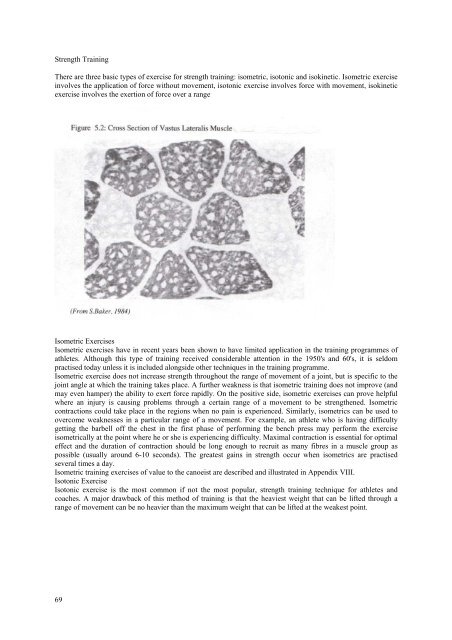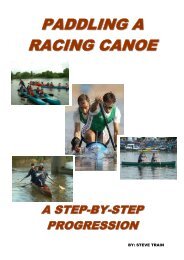The Science of Canoeing By Richard Cox
The Science of Canoeing By Richard Cox
The Science of Canoeing By Richard Cox
You also want an ePaper? Increase the reach of your titles
YUMPU automatically turns print PDFs into web optimized ePapers that Google loves.
Strength Training<br />
<strong>The</strong>re are three basic types <strong>of</strong> exercise for strength training: isometric, isotonic and isokinetic. Isometric exercise<br />
involves the application <strong>of</strong> force without movement, isotonic exercise involves force with movement, isokinetic<br />
exercise involves the exertion <strong>of</strong> force over a range<br />
Isometric Exercises<br />
Isometric exercises have in recent years been shown to have limited application in the training programmes <strong>of</strong><br />
athletes. Although this type <strong>of</strong> training received considerable attention in the 1950's and 60's, it is seldom<br />
practised today unless it is included alongside other techniques in the training programme.<br />
Isometric exercise does not increase strength throughout the range <strong>of</strong> movement <strong>of</strong> a joint, but is specific to the<br />
joint angle at which the training takes place. A further weakness is that isometric training does not improve (and<br />
may even hamper) the ability to exert force rapidly. On the positive side, isometric exercises can prove helpful<br />
where an injury is causing problems through a certain range <strong>of</strong> a movement to be strengthened. Isometric<br />
contractions could take place in the regions when no pain is experienced. Similarly, isometrics can be used to<br />
overcome weaknesses in a particular range <strong>of</strong> a movement. For example, an athlete who is having difficulty<br />
getting the barbell <strong>of</strong>f the chest in the first phase <strong>of</strong> performing the bench press may perform the exercise<br />
isometrically at the point where he or she is experiencing difficulty. Maximal contraction is essential for optimal<br />
effect and the duration <strong>of</strong> contraction should be long enough to recruit as many fibres in a muscle group as<br />
possible (usually around 6-10 seconds). <strong>The</strong> greatest gains in strength occur when isometrics are practised<br />
several times a day.<br />
Isometric training exercises <strong>of</strong> value to the canoeist are described and illustrated in Appendix VIII.<br />
Isotonic Exercise<br />
Isotonic exercise is the most common if not the most popular, strength training technique for athletes and<br />
coaches. A major drawback <strong>of</strong> this method <strong>of</strong> training is that the heaviest weight that can be lifted through a<br />
range <strong>of</strong> movement can be no heavier than the maximum weight that can be lifted at the weakest point.<br />
69



